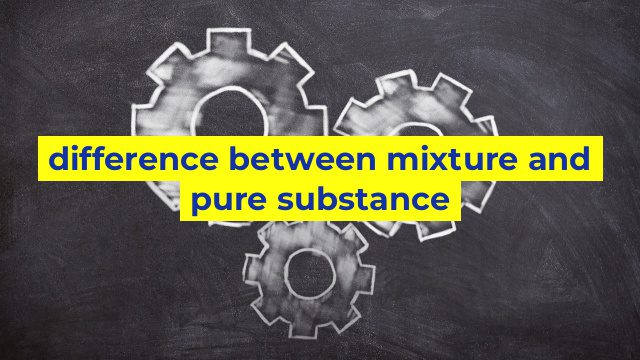Understanding the Difference between Mixture and Pure Substance
When it comes to chemistry, one of the most fundamental concepts is the distinction between mixtures and pure substances. Understanding the difference between the two is crucial, as it can help you comprehend a wide range of chemical reactions and properties. In this article, we will explain the terms “mixture” and “pure substance” and highlight their differences.
Mixtures
A mixture is a combination of two or more substances that are physically mixed together, but not chemically bonded. Mixtures can be either homogeneous or heterogeneous. Homogeneous mixtures have a uniform composition throughout, while heterogeneous mixtures have different components that are not distributed evenly.
An example of a homogeneous mixture is a solution of salt in water. The salt particles dissolve in water, and the resulting solution has a uniform composition. On the other hand, if you mix sand and iron filings, you get a heterogeneous mixture, where the sand and iron filings can be physically separated from each other.
Pure Substances
A pure substance is a chemical substance that consists of only one type of atom, molecule, or compound. Pure substances are characterized by a fixed chemical composition and properties. They can be either elements or compounds.
An element is a pure substance composed of atoms with the same number of protons. For example, gold is an element, and all gold atoms have 79 protons. A compound, on the other hand, is a pure substance that consists of two or more different elements that are chemically bonded together. An example of a compound is water, which consists of two hydrogen atoms and one oxygen atom.
The Main Differences
The main difference between mixtures and pure substances is that mixtures can be physically separated into their components, while pure substances cannot be. Mixtures also have properties that are a combination of the properties of their components, while pure substances have unique properties that are distinctive to them.
Another difference is that mixtures can be either homogeneous or heterogeneous, while pure substances are always homogeneous. Moreover, while mixtures have variable composition, pure substances have a fixed composition.
Conclusion
In summary, mixtures and pure substances are two fundamental concepts in chemistry. While mixtures are a combination of two or more substances that are physically mixed together, but not chemically bonded, pure substances are chemical substances that consist of only one type of atom, molecule, or compound. Understanding the differences between the two can help you to study chemical reactions and properties in depth.
Table difference between mixture and pure substance
| Property | Mixture | Pure Substance |
|---|---|---|
| Definition | A combination of two or more substances that are not chemically combined. | A homogeneous material made up of only one type of substance. |
| Composition | Can vary and is not fixed. | Has a fixed and definite composition. |
| Separation | Can be separated by physical means. | Can be separated by chemical means. |
| Properties | Each component retains its own properties. | Has unique properties. |
| Examples | Salad, air, sand and water mixture. | Gold, water, oxygen and silver are pure substances. |

